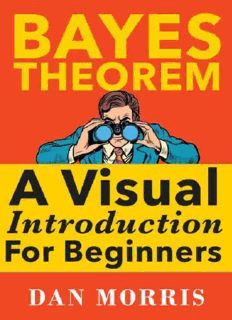
Bayes’ Theorem Examples : A visual introduction for beginners PDF
Preview Bayes’ Theorem Examples : A visual introduction for beginners
Bayes' Theorem: A Visual Introduction for Beginners Dan Morris Bayes' Theorem: A Visual Introduction for Beginners by Dan Morris Published by Blue Windmill Media © 2016 Blue Windmill Media All rights reserved. No portion of this book may be reproduced in any form without permission from the publisher, except as permitted by Canadian copyright law. For permissions contact: [email protected] Cover by Blue Windmill Media Contents Front-Matter: Don't Skip! 1.Bayes Everyday 2.Don’t Waste Your Time 3.Welcome To This Guide 4.Bayes' Theorem Explained: 4 Ways 5.Visual Aids 6.Booklet Structure 7.A Visual Intro: Part 1 8.Basic Definitions 9.A Visual Intro: Part 2 Examples 10.Example Section 1: Solving For One Possible Outcome With All Data Provided 11.How To Understand Scenarios 12.Example Section 2: Solving for One Possible Outcome With No P(B) Provided 13.Example Section 3: Solving For Two Possible Outcomes With All Probability Data Provided Bonus Stuff You'll Like 14.History and Stories 15.Thinking Like A Bayesian Everyday 16.Reference: Definitions, Notations, and Proof 17.Recommended In-Depth Reading 18.Bibliography Bayes Everyday If you’ve recently searched for something on Google, Bayes' Theorem was used to display your search results. The same is true for those recommendations on Netflix. Hedge funds? Self-driving cars? Search and rescue? Bayes' Theorem is used in all of the above and more. At its core, Bayes' Theorem is a simple mathematical formula that has revolutionized how we understand and deal with uncertainty. If life is seen as black and white, Bayes' Theorem helps us think about the gray areas. When new evidence comes our way, it helps us update our beliefs and create a new belief. Ready to dig in and visually explore the basics? Let’s go. Don’t Waste Your Time A few points to help you make the most of this booklet: 1. CHANGE YOUR SETTINGS. If you are reading on a Kindle E-reader, change your settings! It will make reading this booklet MUCH EASIER. For spacing, select the mid-range option (on Kindle Paperwhite, the middle option). For margins, select the widest option. For orientation, select portrait. For font, select Bookerly, and font size select the third smallest option (at least on the Kindle Paperwhite). 2. This booklet is designed as a visual introduction to Bayes' Theorem. It is for BEGINNERS. If you already have a general understanding of the Theorem, you might not get much out of this book. 3. You don’t need to read front to back! Skip around to what you find the most helpful. Welcome To This Guide Welcome to Bayes' Theorem: A Visual Introduction for Beginners. This booklet is packed with examples and visual aids to help clarify what Bayes' Theorem is and how it works. At its core, Bayes' Theorem is very simple and built on elementary mathematics. Before we dig into different definitions, it needs to be stated that Bayes' Theorem is often called Bayes' Rule or Bayes' Formula. So, don’t be confused - they are the same, and we will be using both theorem and formula throughout this booklet. Second, we need to make it clear that Bayes' Theorem is a law of probability theory. It helps us work with, revise, and understand probabilities when we are presented with new evidence. Practically speaking, the theorem helps us quantify or put a number on our skepticism and make more informed, rational choices. It helps us answer the following: When we encounter new evidence, how much should it change our confidence in a belief? Here are a few examples: You just had a test for cancer and it came back positive. What is the probability that you have cancer if the test is positive? Your friend has a new dog and when you visit she slobbers all over you, but does that mean the dog likes you? What is the probability that the dog likes you given that she licks you? Your friend claims that stock prices will decrease if interest rates increase. What is the probability stock prices will decrease if interest rates increase? You were just pulled over by the police and given a breathalyzer test. It came back positive. What is the probability you are truly drunk, given that the test is positive? Bayes' Theorem Explained: 4 Ways Here are a few ways Bayes' Theorem can be explained: 1. Bayes' Theorem helps us update a belief based on new evidence by creating a new belief. 2. Bayes' Theorem helps us revise a probability when given new evidence. 3. Bayes' Theorem helps us change our beliefs about a probability based on new evidence. 4. Bayes' Theorem helps us update a hypothesis based on new evidence. The only problem? Applying the theorem is not intuitive, at least not for most people. This is where visualizing a problem that entails using Bayes' Theorem can be a BIG HELP.
Description: